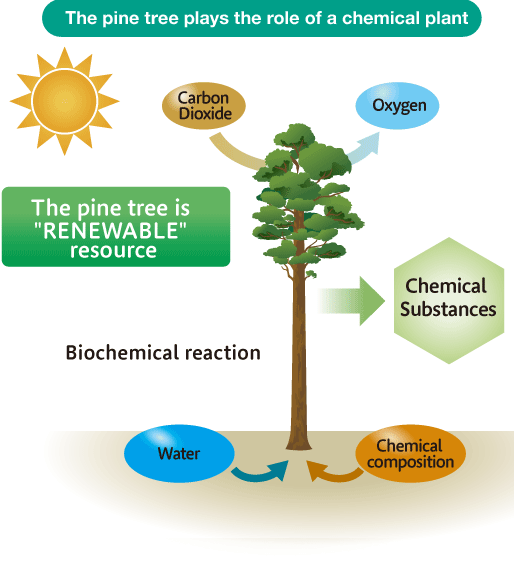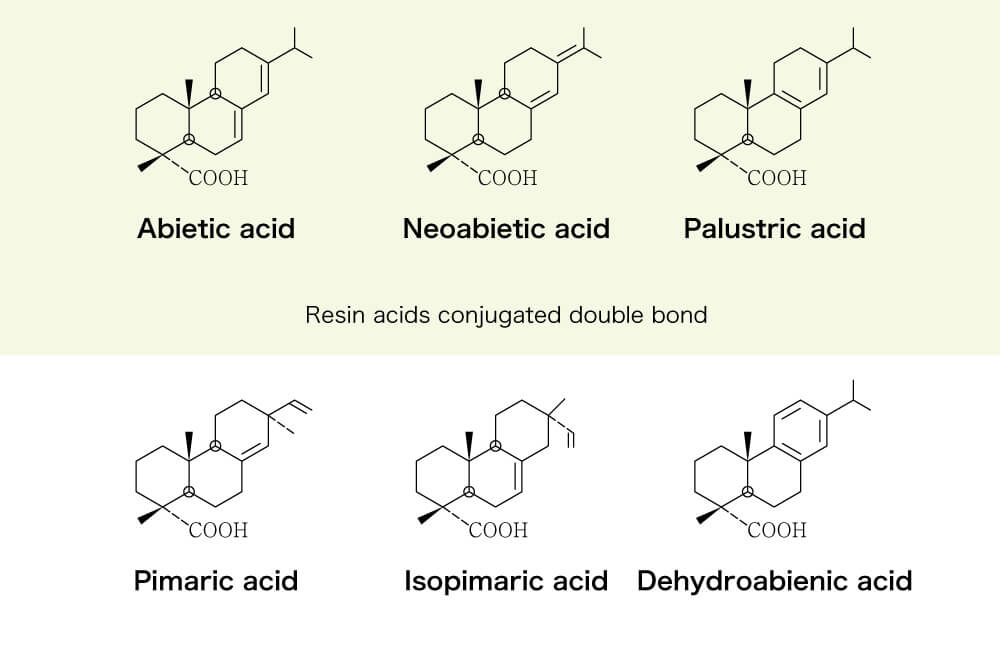An Overview of Pine Chemicals
The term "pine chemicals" refers to the rosin, fatty acids, turpentine and other useful chemical resources obtained from the pine tree.


Pine trees performs photosynthesis, a process by which solar energy transforms carbon dioxide and water into the oxygen we humans and other life depend on for survival.
At the same time, pine trees absorb water and nutrients through their roots, subsequently growing and synthesizing cellulose, a fiber-material, and chemical substances.
Therefore, we can say that a pine tree is a natural chemical factory.
A pine tree is a truly remarkable renewable resource, with a stable supply of sunlight and water, coupled with constant plantation. We seek to find a harmonius balance between technology and nature in efforts to maximzie our utilization of the chemical resources it has to offer.
What is Rosin?
Rosin is a nonvolatile component of crude gum which is included largely in plants belonging to pine family (Pinaceae). It mainly consists of a various isomer technically called resin acids.

Resin acid composition
| Abietic acid | Neoabietic acid | Parastrinic acid | |
|---|---|---|---|
| Tall Oil Rosin | 33-48 | 2-8 | 10-20 |
| Gum Rosin | 25-45 | 10-25 | 10-25 |
| Wood Rosin | 35-45 | 2-10 | 10-20 |
| Pimaric acid | Isopimaric acid | Dehydroabienic acid | |
|---|---|---|---|
| Tall Oil Rosin | 3-8 | 4-10 | 15-25 |
| Gum Rosin | 4-8 | 2-8 | 3-7 |
| Wood Rosin | 5-8 | 10-15 | 10-15 |
Quality of different rosins
| Acid value | Softening point(℃) | Color Grade | |
|---|---|---|---|
| Tall Oil Rosin | 165-175 | 70-75 | N-X |
| Gum Rosin | 165-175 | 70-75 | N-X |
| Wood Rosin | 160-170 | 70-80 | D-X |
What is Crude Tall Oil?
In the kraft-pulp making process, black liquor is produced from pine wood chips (as a by-product), and by neutralizing the black liquor with acid, crude tall oil, which contains resin component can be separated. By distillating crude tall oil, we can obtain tall oil rosin, tall oil fatty acid, which are used industrially. In Japan, Harima Chemicals operates the only distilation plant in Kakogawa, Hyogo prefecture.
What is Tall Oil Fatty Acids?
Tall oil fatty acids (TOFAs) are fatty acids obtained by the fractionation of crude tall oil. They contain oleic acids (50%), linoleic acids (35%), and others (8%).
Through dimerization of unsaturated fatty acids, TOFAs are modified into dimer acids, and then used as raw material for polyamide amines used for epoxy curing agents and thermoplastic polyamide resins, which are used in paints, inks, and adhesives.
What is Turpentine?
Turpentine is also referred to as gum turpentine, wood turpentine, and sulfate turpentine, depending on the production process.
Its major components are α-pinene and β-pinene, which are used as solvent for paints and varnish. In addition, turpentine is used as a thinner and medium in art painting. Other uses include applications as a pharmaceutical ingredient and α-pinene is used as raw material for synthetic camphor.
Pyrolysis of pinene generates myrcene, which is widely used in the fragrance industry as the raw material for menthol, citral, citronellol, citronellal, geraniol, nerol, and linalool.
